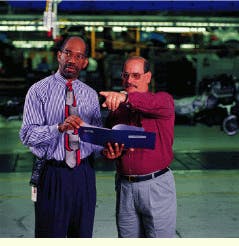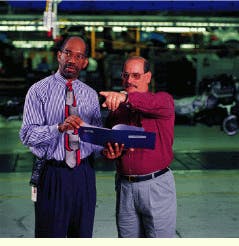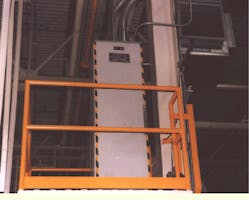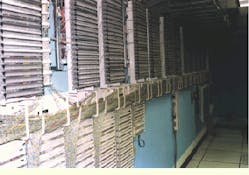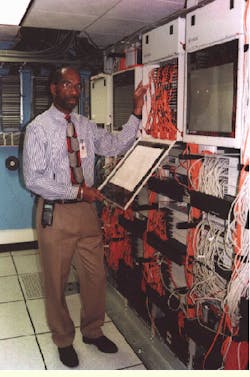Designing a structured cabling system for Mercedes-Benz involved both risks and rewards.
Tim A. Lewis / T.A. Lewis & Associates Inc.
In 1994, after fierce competition among several states, German auto giant Daimler-Benz--the parent company of Mercedes-Benz U.S. International (mbusi)--chose Alabama as the site of its U.S. manufacturing plant. Along with the financial incentive packages offered by the state, the commitment of Alabama`s business community to ensure that this one-of-a-kind facility would be built correctly and on time was cited as an important factor in the auto maker`s decision. Needless to say, competition to work on such a high-profile project was intense. Potentially prestigious and lucrative, it was a dream project for many companies. We at T.A. Lewis & Associates Inc. (tala--Birmingham, AL) certainly felt that way.
The scope of the project was substantial, as mbusi wanted a turnkey information-technology solution with a single point of contact for the hardware, software, wiring, and support personnel. Partnering with ibm Global Services (New York City), which would provide the data systems, tala was to design the data-communications network and provide project management for the installation of the copper and fiber-optic cabling in the Vance, AL, plant.
The original scope of the project was expanded several times as the work progressed. In addition to the premises-cabling work in the primary plant, the project grew to encompass the outside-plant cabling that connects various other buildings at the plant site--the energy center, hazardous waste, shipping and receiving, guard and truck entrances, and the training center.
High risks
Along with the project`s scope, the stakes were also considerable. The project represented a potential 50% increase in revenue for tala. But, to execute the job, we had to increase the staff of our seven-year-old company by 40%. Also, the high profile of the project meant that it could easily solidify our good reputation--or decimate it. We were aware early on that we needed to be wide-awake to make our dream project a success.
The first step of the project was to collaborate with mbusi`s information technology staff, ibm, the architects, and the engineers to determine the number and locations of the telephones, computer terminals, electronic systems, and intermediate distribution frames (idfs). We also needed to discuss routing for the cable trays and conduits and the layout for the data center.
"In a huge and complex facility such as the Mercedes plant, it is very helpful to know the points the cables go through before we physically go and locate them," says Tommy Fitzhugh, project manager in charge of day-to-day system management at the plant. "Having a `cabling road map` really helps in managing the system."
Andy Daffron, information technology coordinator for mbusi, adds, "It was a major communications project. Not only was it a new construction requiring a complex wiring infrastructure to support the manufacturing function, but it also had a very tight timeline."
The network was designed in a client/server configuration, with a main computer room and three telecommunications closets located in various administrative areas and 26 idfs throughout the plant. In a manufacturing environment, the needs of the production line take priority, so several of the idfs were located on raised platforms 20 feet off the floor to make the most of the available floor space.
The second step was to develop a structured cabling system that would provide ibm and mbusi with a warranty of 15 years or more on the infrastructure. We looked at a number of structured cabling systems before determining that the Belden-Krone solution would best fit this application. Deciding factors included their 15-year warranty, established track record, and level of support and training. Over the course of the project, tala developed a strong working relationship with both Belden Wire & Cable Co. (Richmond, IN) and Krone Inc. (Englewood, CO). We were certified for installation, maintenance, and warranty on their structured cabling system, allowing us to deal directly with Belden-Krone when placing and expediting large orders.
Next, we determined the type, count, and amount of fiber and copper that would go into the plant, where the cabling would be pulled, and the type of conduit and cable trays that would be installed. We chose electrical metallic tubing conduit and rung-type cable trays. For the network backbone, we chose 36-count singlemode fiber-optic cable from Siecor Corp. (Hickory, NC) and DataTwist 350 Category 5 cable from Belden for the horizontal cabling.
Redundancy was an important element of the design. The nature of the plant dictated that the production line not be disrupted in case of a cable cut or other problem. To prevent such an occurrence, alternate cable routes were designed into all of the pathways to the idfs. As a result, should a problem occur, rerouting could be accomplished with relative ease.
Staffing was a major issue that had to be addressed. Working out of tala`s on-site office, we needed an overall project manager, premises-distribution specialist, draftsperson, cable-record administrator, and several consultants. This staff was responsible for all project activities. In addition to our partnering relationship with ibm, we developed working relationships with a number of vendors who provided support services. The project size and timeline dictated that at times we had three different vendors and subcontractors with three or four crews working in different areas of the plant. As a result, we were able to complete our work on schedule.
Due to the enormous amount of cable needed and the fast-track nature of the project, material management became critical. Our solution was to contract on- and off-site storage facilities in close proximity to the plant and to implement comprehensive inventory controls. tala also instituted an internal change-control team, which was charged with verifying, pricing out, and reviewing alternate solutions before they were submitted to the mbusi it/ibm team for approval.
System management
One of our goals throughout the project was to provide a foundation for effective system management after the cabling installation was completed. To establish this foundation, we developed a comprehensive set of cable records and associated drawings using Autocad software by AutoDesk Inc. (San Rafael, CA).
CableMaster cable-management software (cms) from The Angeles Group (Westlake Village, CA) allowed us to load the cable records, build the Autocad drawings, and then interface the two. These procedures were ongoing as the infrastructure was being installed. Using the Autocad interface, we created drawings that illustrate the cable routes--where they start and end as well as all the intermediate points. The database included cable routes, idf locations, available cable pairs, jack identification, and other information that is necessary to ensure sufficient capacity for expansion and rerouting. Since tala has been awarded the system-management contract, we have been able to verify the efficiency of the cms. We use the software to track where we have extra capacity to hook up more computers and telephones.
Along with providing on-site personnel, tala offers additional support staff from the corporate office for Autocad and cable-management documentation. We perform moves, adds, and changes, update documentation, and install and manage the hubs and other electronic equipment in the idf cabinets.
Challenges galore
One of the primary challenges of this project was its newness. It was a new plant, located in a new country to produce a new vehicle--the M Class Sport Utility Vehicle. In addition, the facility was being built by a team of architects, engineers, and technology experts who had not previously worked together. Therefore, everyone involved had to help create efficient and effective ways to communicate and work together.
"Remaining fluid and flexible was a key management strength for us in this project," says Cassie Clevenger, tala`s vice president of consulting services, who was in charge of the mbusi project. "So many details can change from day to day in a new construction project. You have to contend with weather delays, shipping difficulties, and errors with other disciplines that may affect your scope. In keeping with the tradition of learning something new in every completed project, I would have to say this project taught us just how flexible we could be."
Coordinating shared resources and activities posed another logistical challenge. At the height of the project, tala alone had three different crews on-site, with 20 to 30 people--all with different skill sets, such as fiber or copper installation, premises or outside-plant skills, and verification and testing experience --working in as many as five different areas of the plant.
Working around other trades was also difficult. "Traffic jams" were common when a number of trades--electrical, mechanical, or cabling crews--were all working in the same areas. Often the lifts were unable to move past each other in the plant. By staggering schedules with the other trades, we were able to resolve this problem.
Looking back, lessons learned
In retrospect, we should have planned our material management better. Because of the large amount of cable needed at a precise time, it was often hard to get the materials delivered when needed. These delays resulted in idle crews, which escalated costs. We learned from this experience that in similar future projects, we should increase the amount of stockpiled materials.
Our greatest success on this project was that despite the scope and complexity, tala was able to design and install a structured cabling system that was certified by the manufacturer for a 15-year warranty. Delivering the system on time necessitated working nights, weekends, and holidays, as well as frequently having to double our manpower--but we got the job done. We completed the installation in just 12 months.
On the mbusi project we designed and installed more than 4 miles of copper and 12 miles of fiber in the plant. In the process, we regularly had to find solutions to problems we never knew existed. The demands on our staff were rigorous physically and intellectually.
The reality of our dream project was that it was often more difficult than we had anticipated. But in some ways, it was also more rewarding. Not only did we successfully meet the challenges; we also formed a variety of partnering relationships that will continue to provide benefits long into the future.
In fact, when all is said and done, perhaps the best way to sum up the realities of our dream project is to say that, while it wasn`t easy, we frequently find ourselves dreaming of another project just like it.
Tim Lewis (left), president of T.A. Lewis & Associates Inc., and Tommy Fitzhugh, project manager, review the design of the cabling infrastructure.
Because of the premium placed on floor space in the manufacturing environment, this intermediate distribution frame is raised off the floor onto a platform.
Riser cables from all over the plant crossconnect to the telephone switch in the main computer room.
Fiber-termination panels in the main computer room crossconnect to the hubs to operate all the computer equipment in the Mercedes plant. Tim Lewis reviews fiber connections to the main hubs.
Tim A. Lewis is president of T.A. Lewis & Associates Inc. (Birmingham, AL), a telecommunications consulting firm.
